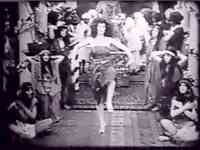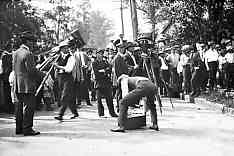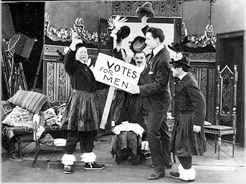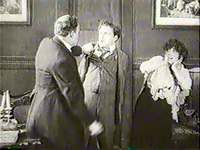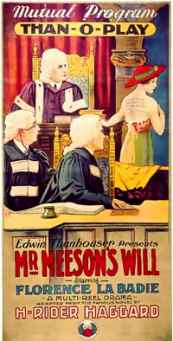Thanhouser Films: An Encyclopedia and History, 1909-1918. Q. David Bowers, foreword by Anthony Slide. Lanham, MD: Scarecrow Press, 1997. ISBN 0-8108-3455-3. CD-ROM release 1.0 for IBM compatible PCs with Windows 3.1 or Windows 95. Produced by Thanhouser Company Film Preservation, Inc. in cooperation with the Library of Congress. More information is available at the following Web site: www.teleport.com/~tco/cdrom.htm. The Thanhouser Company, founded in 1909, operated outside the control of the Edison and Biograph-dominated Motion Picture Patents Company "trust."
Thanhouser Films: An Encyclopedia and History by Q. David Bowers is thus a terrific resource for anyone interested in the history of American film, and in how movies produced by one early film studio commented on tensions and concerns of American culture during the Progressive Era. The project encompasses a company history of an unjustly neglected film studio, its personnel, performers, and film releases. It single-handedly rescues the Thanhouser Company from obscurity and re-establishes its importance as one of the major film producers from the late-nickelodeon era up to the First World War. Yet the Thanhouser Films CD-ROM provides so much more than a single book could; it is not only a compendium of information about the studio, its films, players, directors and producers. Through the author’s tremendous research effort, it also contains thousands of primary documents—original reviews and news articles from film trade journals and entertainment industry newspapers, advertisements and publicity releases, local newspaper stories, and items from the early fan magazines—plus more than 400 images and over 20 minutes of film clips.
What makes this volume so valuable to academics and movie buffs alike are the thousands of excerpts from articles in local newspapers, the film business trade journals, and other primary sources. The author and his assistants spent hundreds of hours reading microfilm for this project, combing through all the significant entertainment trade journals of the day—Moving Picture World, the Nickelodeon, Billboard, Exhibitors Trade Review, Moving Picture News, New York Dramatic Mirror, Exhibitors Herald, Film Index, and Variety. Bowers also drew from rare studio publicity material, such as the Mutual publication Reel Life; and from the earliest fan magazines Motion Picture Story Magazine and Photoplay.
The CD-ROM’s second volume, the filmography, contains entries on more than 1,000 documented Thanhouser releases. Each entry includes cast, director and producer; the text of trade paper advertisements and publicity releases; synopses and selected reviews and articles from Moving Picture World, the New York Dramatic Mirror, and many other sources. There are also detailed notes on production and cross-references to discussion of the film in the narrative history. There are clips from 33 films and illustrations from many more. The films are searchable chronologically, alphabetically, or by word. The search function quickly moved examination of film themes far beyond the often-innocuous film titles to demonstrate that the Thanhouser Company produced hundreds of one-reel films drawn from the headlines and concerns of the Progressive Era of reform.
The majority of Thanhouser’s brief films dealt with human relationships; it was not surprising to find 544 entries dealing with love. There were also 56 mentions of revenge, 73 films involving murder, 78 on crime in general, and 22 films mentioned hate. Twenty-three film themes involved divorce and eight plots revolved around prejudice. Children were important to the plots of 412 films, and hundreds of entries turned up in searches for fathers, mothers and families. The Thanhouser studio output apparently leaned toward dramatic themes—searching the filmography uncovered 431 entries mentioning comedy and 758 descriptions of dramas. Some films, obviously, had elements of both. Only 63 were described as melodramas, however. Thanhouser also overwhelmingly focused on producing narrative fiction films, as the term documentary came up in only 27 entries.
Bowers writes that "Thanhouser films were as varied as the medium of motion pictures itself. On the one hand were classics—
Searches located 14 films mentioning Dickens, 27 concerning Shakespeare, 22 involving literature and 56 described as having historical themes; while not large totals, these self-consciously "high-class" films packed a prestigious punch for the studio with critics. Bowers was amused to find the range of opinion on the studio’s releases in his research: "Time and again one reviewer considered a given Thanhouser film to be just about the best ever, while another reviewer with equal conviction consigned it to the trash can." "It wasn't long after the Thanhouser Company was established that it was considered by reviewers to be head and shoulders above other Independent firms. If one word could summarize the Thanhouser reputation during the early years it is quality," writes Bowers. "In 1913 in nationwide popularity contests held by America's two most important fan magazines, Motion Picture Story Magazine and Photoplay Magazine, Thanhouser players [especially Florence LaBadie, Muriel Ostriche, Marguerite Snow, Mignon Anderson and future-director James Cruze] far outswept the entries of any other studio." Thanhouser’s 23-episode serial of 1914, "The Million Dollar Mystery," was the most profitable serial yet produced, earning more than a million dollars. As Bowers notes, "Clearly, in its day the Thanhouser film enterprise and its players comprised a key element of the industry."
In the view of someone who has small experience with CD-ROM technology, this project is quite well organized and user-friendly. While it is a little daunting to encounter so much text single-spaced on a computer screen, those are problems inherent in computerizing three entire book manuscripts. The creative research possibilities that the search function make possible, however, easily outweigh those minor frustrations. This is not an academic film history, for there is no mention of the outstanding recent scholarly books on early American film history or film theory, and the author attempts no analysis of film content or acting styles. But as a good story and a resource for primary documents, it is marvelous, and it provides fodder for several dissertations and a host of journal articles. Perhaps it may also inspire work on other important but sadly neglected early studios such as Kalem and Essanay. The Thanhouser Films CD-ROM project truly represents a labor of love for Bowers and the founder’s grandson Edwin Thanhouser, in the attention to detail and the inclusiveness of its coverage of the films, people and history of the Thanhouser Company. The Library of Congress also provided invaluable support for the project. For making all this material available in an innovative format for researchers and readers, we should be grateful to them all. Check out the Thanhouser Company Film Preservation, Inc., Web site at http://www.teleport.com/~tco/index.htm for more history, images, film clips and information about the CD-ROM and videotape collections of Thanhouser films. Kathryn Helgesen FullerVirginia Commonwealth University ~ End ~ CD-ROM Review of Thanhouser Films: An Encyclopedia and History, 1909-1918 Copyright © 1999 by The Journal for MultiMedia History Comments | JMMH Contents |
